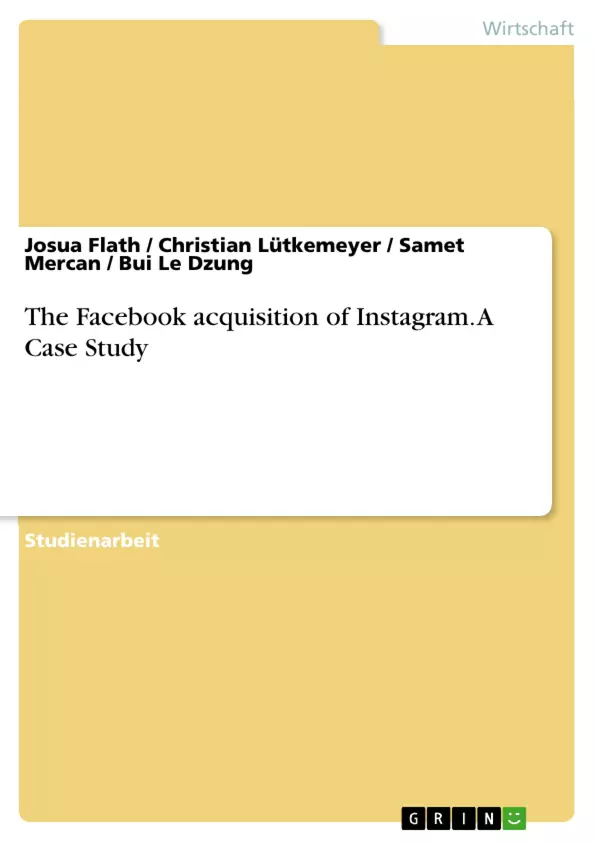On April 9th 2012 Facebook announced its acquisition of the application Instagram for nearly $1 billion including $300 million in cash and the rest in stock. The acquisition was finalized on September 6th with an offer of $736 million. In this case study we want to examine what the reasons of Facebook were to spend such an amount of resources and especially what the acquisition means for Facebook’s long-term strategy.
We are going to tackle this research question in the following way:
1. We will introduce shortly the advertisement industry to the reader and explain what the typical common/shared strategies are for different parts of the industry (e.g. social network websites, radio, television, papers etc.)
2. Afterwards the strategy of Facebook before the acquisition will be elaborated so that a comparison can be made with the overall advertising strategy and how this made Facebook so popular.
3. The acquisition event:
3.1 First an analysis will be made of the reason behind the acquisition of Instagram (Facebook was going IPO in may or was the acquisition purely strategical for long-term ends, maybe both?)
3.2 What was the reason behind the fast and high valued acquisition? The bidding was quite high, was this for strategical purposes? (Gaining Instagram faster might mean faster “innovation/integration.”)
4. Analysis of the possible changes in the strategy of Facebook after the acquisition and application of 5D and 7D analysis.
5. Finally we will give a conclusion/evaluation about the event and make propositions of long-term strategic recommendations based on 5D and 7D analysis made in the previous section.
Inhaltsverzeichnis
- Introduction
- Facebook's History
- Making Facebook a business
- The social media market environment
- Bargaining Power of Customers
- Competitors of Facebook
- Threat of New Entrants
- Threat of Substitute Products
- Competitive Rivalry within the Industry
- Challenges ahead
- Conclusion
Zielsetzung und Themenschwerpunkte
Die Fallstudie analysiert die strategische Situation von Facebook und Instagram. Sie untersucht die Entwicklung der beiden Unternehmen, die wichtigsten Geschäftsmodelle sowie die Wettbewerbssituation im Social-Media-Markt. Darüber hinaus beleuchtet die Studie die Herausforderungen, denen Facebook und Instagram im digitalen Zeitalter gegenüberstehen.
- Entwicklung von Facebook und Instagram
- Geschäftsmodelle und Strategien von Facebook und Instagram
- Wettbewerbsanalyse im Social-Media-Markt
- Zukünftige Herausforderungen für Facebook und Instagram
- Die Rolle von Innovation und Technologie im Social-Media-Bereich
Zusammenfassung der Kapitel
- Introduction: Die Fallstudie stellt die Unternehmen Facebook und Instagram vor und erläutert den Hintergrund der Fusion der beiden Unternehmen.
- Facebook's History: Dieses Kapitel beschreibt die Entstehung und Entwicklung von Facebook von seiner Gründung als Plattform für Studenten bis hin zum globalen Social-Media-Giganten.
- Making Facebook a business: Hier wird das Geschäftsmodell von Facebook vorgestellt, insbesondere die Rolle von Werbung und die Monetarisierung des Nutzerstamms.
- Instagram: Dieses Kapitel beleuchtet die Entstehung und Entwicklung von Instagram als Foto-Sharing-Plattform, die schnell an Popularität gewonnen hat.
- The social media market environment: Dieser Abschnitt befasst sich mit der Analyse des Wettbewerbsumfelds im Social-Media-Markt, wobei die fünf Wettbewerbskräfte von Porter (Verhandlungsmacht der Kunden, Wettbewerb unter den Unternehmen, Bedrohung durch neue Anbieter, Bedrohung durch Ersatzprodukte und Verhandlungsmacht der Lieferanten) im Detail betrachtet werden.
Schlüsselwörter
Social Media, Facebook, Instagram, Geschäftsmodell, Plattformökonomie, Werbung, Monetarisierung, Wettbewerbsanalyse, Porter's Five Forces, Innovation, Technologie, Digitalisierung, Mobile-First, User Experience, Digital Marketing, Social Commerce, Online-Werbung.
- Quote paper
- Josua Flath (Author), Christian Lütkemeyer (Author), Samet Mercan (Author), Bui Le Dzung (Author), 2013, The Facebook acquisition of Instagram. A Case Study, Munich, GRIN Verlag, https://www.grin.com/document/275569



